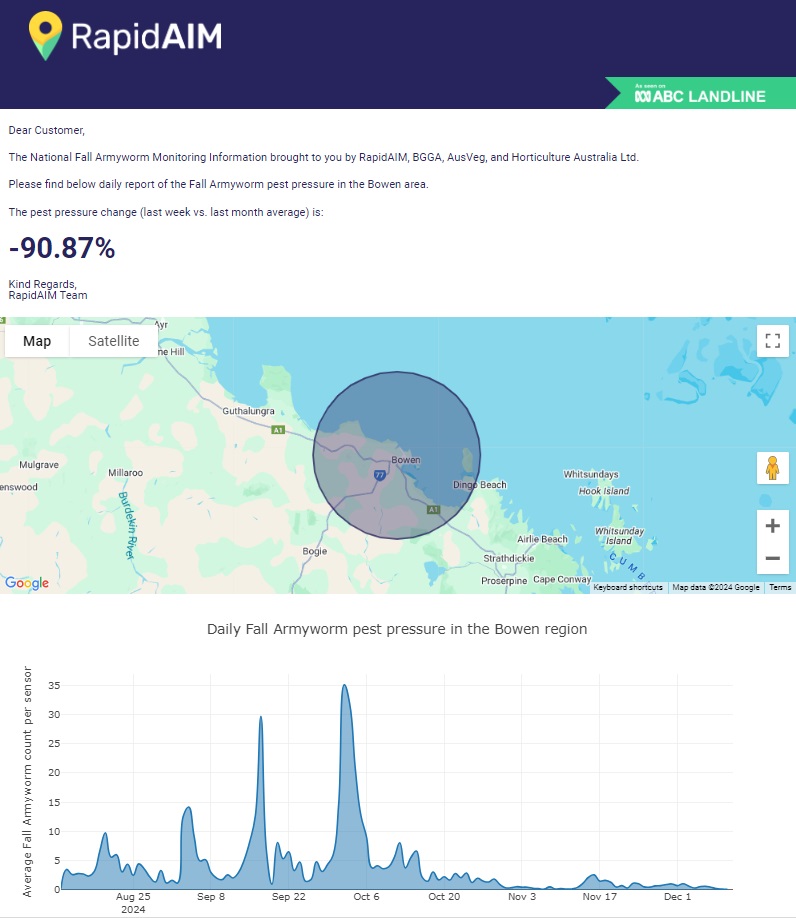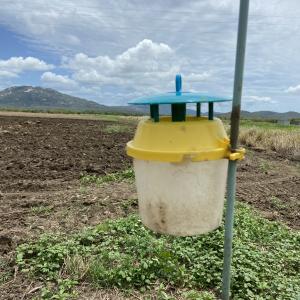Funding
.png)
Thank you for taking a moment to share your feedback on the fall armyworm eHub. Your input will help us improve the site and ensure it continues to provide users with valuable and relevant information. Please click the link to complete the survey and help guide future updates.
On this site you can engage with the latest fall armyworm (FAW) research, development and extension (R, D & E) activities for horticulture:
To receive updates on information added to this page, register on this eHub and 'follow' the fall armyworm project.
This eHub page is delivered as part of the Hort Innovation funded project VG22006 'National Fall Armyworm (FAW) innovation system for the Australian vegetable industry'.
Stay up to date with fall armyworm (FAW) research, development, and extension activities across FAW area-wide management regions.
The national FAW extension project (VG22006) is establishing area-wide management groups in the Bowen / Burdekin (North Queensland), Lockyer Valley (South East Queensland) and East Gippsland (Victoria) regions. In each region, researchers and extension officers are working with growers, agronomists, and industry participants to generate knowledge and tools for sustainable FAW management through a range of activities. Here are the activities currently underway. For questions or feedback, click on the contact name to email the researcher or extension officer or use the 'Questions and Information Request' tab at the top right corner of the FAW eHub.
.jpg)
Demonstration / trial sites:
Biopesticides trial to manage FAW in sweet corn (Ian Newton)
Exploring FAW sources, NPVs efficacy in conjunction with pesticides (John Stanley)
FAW monitoring: Pheromone trapping (John Stanley)
Engagement activity, extension and communication: Field walk, Industry meeting (Ramesh Puri)
Lockyer Valley, South East Queensland (2025-2026).jpg)
Sweet corn varietal trial to understand the feeding behaviour of FAW -
FAW collection in Lockyer and Fassifern Valley for insecticide resistance testing -
FAW industry meeting/field day (sometime Feb or March) –
FAW monitoring: Pheromone trapping (Frezzel Tadle)
FAW collections for inclusion in the resistance screening, with a focus on grain crops (maize in particular), complement the collections from horticultural crops being made by Praise
Participation in the development of an IRMS for FAW, with consideration for insecticide use patterns in non-horticultural crops grown in the region.
Engagement activity: Farm walk and Industry meeting (Frezzel Tadle)
East Gippsland, Victoria (2025-2026).jpg)
FAW monitoring: Pheromone trapping (Scott Botten)
FAW identification: LAMP testing (Scott Botten)
Engagement activity: Farm walk, Industry meeting (Scott Botten)
Stay up to date with activities across all FAW area-wide management regions through the FAW eHub and newsletter (Ramesh Puri).
(Image credit: location pins designed by rawpixel.com / Freepik)
Stay up to date with fall armyworm (FAW) research activities across Australia. Various organisations are working on FAW management solutions including biological control, companion planting, and crop and pest monitoring.
Below are some of the activities currently underway. For questions or feedback, click on the contact’s name to email the researcher or use the 'Questions and Information Request' tab at the top right corner of this page.
Department of Primary Industries, Queensland in 2025/26:
Lockyer Valley/Toowoomba DPI, Qld
Macquarie University
 Growers in the Lockyer Valley, Bowen region, and Wide Bay Burnett can now see daily updates on fall armyworm (FAW) activity in their region, thanks to a groundbreaking project, “FAW National Surveillance,” exploring the use of RapidAIM traps to combat the invasive pest. The project is led and implemented by Bowen Gumlu Growers Association with funding through the VegNET Innovation fund. The project will utilise the National Vegetable Extension Network team of Regional Development Officers to coordinate and install the RapidAim traps and provide support to participating growers. This project aims to provide growers with real-time data on FAW populations, empowering them to make informed decisions about pest management strategies. As the network of RapidAIM traps rolls out, data provided by the internet-connected traps is fed into the National Fall Armyworm Monitoring Information pages.
Growers in the Lockyer Valley, Bowen region, and Wide Bay Burnett can now see daily updates on fall armyworm (FAW) activity in their region, thanks to a groundbreaking project, “FAW National Surveillance,” exploring the use of RapidAIM traps to combat the invasive pest. The project is led and implemented by Bowen Gumlu Growers Association with funding through the VegNET Innovation fund. The project will utilise the National Vegetable Extension Network team of Regional Development Officers to coordinate and install the RapidAim traps and provide support to participating growers. This project aims to provide growers with real-time data on FAW populations, empowering them to make informed decisions about pest management strategies. As the network of RapidAIM traps rolls out, data provided by the internet-connected traps is fed into the National Fall Armyworm Monitoring Information pages.
VegNET 3.0 is a vegetable and onion industry extension program nationally coordinated by AUSVEG and funded by Hort Innovation using the vegetable and onion research and development levies and contributions from the Australian Government.
As part of a new variation to VG22006 National Fall Armyworm Innovation System project, monitoring is being initiated to address the growing concern of insecticide resistance in fall armyworm (FAW) populations within the horticulture industry. This expansion of the project reflects national priorities and industry feedback, highlighting the urgent need for coordinated resistance monitoring, reporting, and management strategies.
A total of 24 growers, agronomists, and researchers from Lockyer Valley and Fassifern Valley gathered at the Gatton Research Facility in mid-September to discuss previous trial results and ongoing research on fall armyworm. Dr. Melina Miles, an entomologist from QDPI presented results from trials conducted as part of the VG23006 investment (Hort Innovation & QDPI), which included the following:
The Bowen–Burdekin FAW industry meeting brought together 24 growers, agronomists, researchers, and service providers to exchange research updates and field observations on fall armyworm (FAW) management. Key discussions covered unusually high FAW pressure in the Burdekin, promising results from pupae-busting trials, and improvements in monitoring tools such as pheromone traps and RapidAIM sensors.
This joint research activity represents early attempts by the team to practice participatory action research by fostering collaboration, cooperation, and trust, and by providing opportunities for immediate shared learning among growers, agronomists, and researchers. The pupae-busting trial highlighted the value of visual tools—such as emergence cages that reveal unseen parasitoids—to stimulate reflection and build understanding of pest ecology among growers and researchers alike.
From a collection of 1,900 fall armyworm larvae in Western Australia and the Northern Territory, researchers identified ten species of larval parasitoids as well as two species of egg parasitoids. Among the larval parasitoids, Cotesia ruficrus and Exorista xanthaspis were found to be the most abundant, accounting for 56.14% and 50%, respectively. The two egg parasitoid species recorded had parasitism rates of 7.81% for Trichogramma pretiosum and 10.16% for Telenomus remus.
Over the last two years, fall armyworm (FAW) has become a potential pest in Victoria for current and future climates, with impacts on corn and maize crop production along with risks to many other grains and horticultural crops.
.png)

Updated: 18 November 2025
The average pheromone trap catches recorded 2.75 moths (count per trap in a week).
FAW counts from pheromone traps set up at the Bowen Research Facility have decreased in line with the end of the crop season.

Updated: 18 November, 2025
Various peak values have been recorded, with most occurring during the warm weather season. Since the initiation of the trapping program, the highest number of male moths collected on traps was between January and February 2024.
Weekly moths catch: 19/ week

Updated: 18 November, 2025
A pheromone trap baited with Pherolure was deployed at Tenthill, Lockyer Valley, in February 2025 during the sweet corn growing season.
Weekly male moth catch: 8 / week

Updated: 1 May 2024
The highest moth catches were observed in March and April 2024, likely due to warmer weather and the primary growing season for host crops, which encouraged increased pest presence.
The videos are from Fall armyworm events and field activities.

